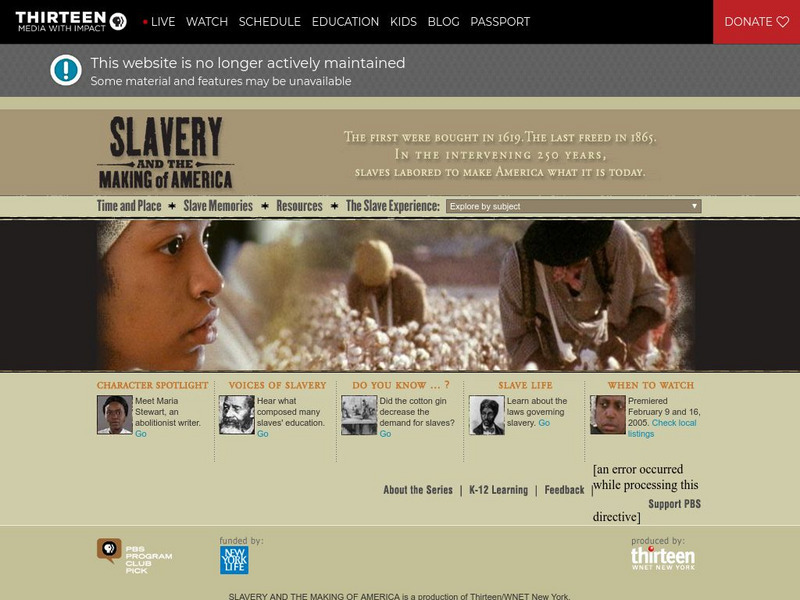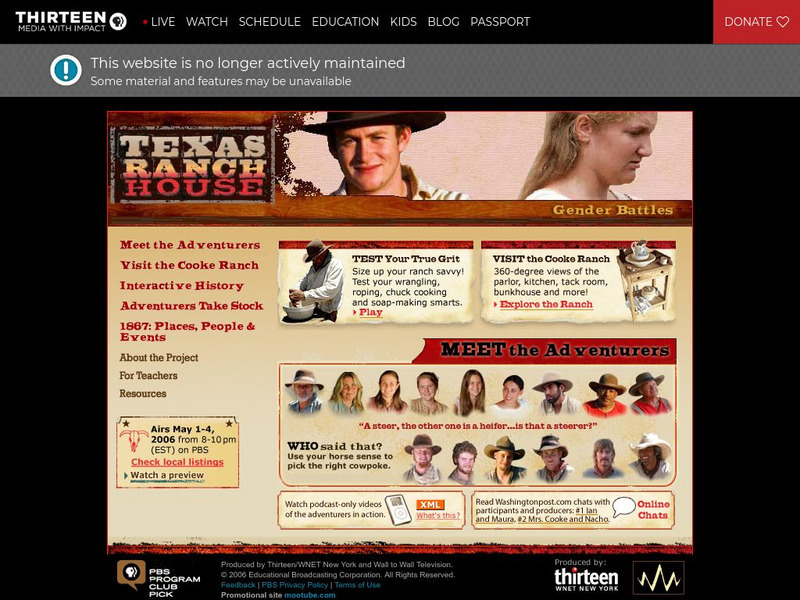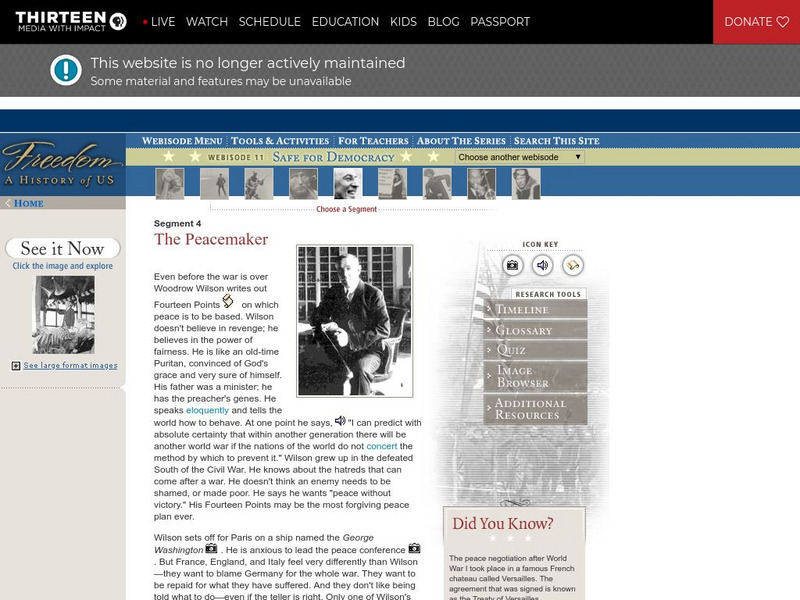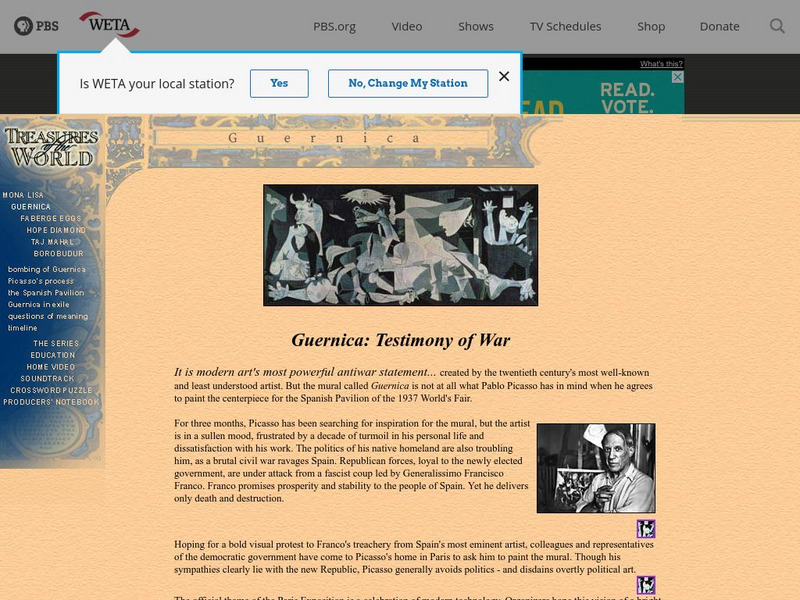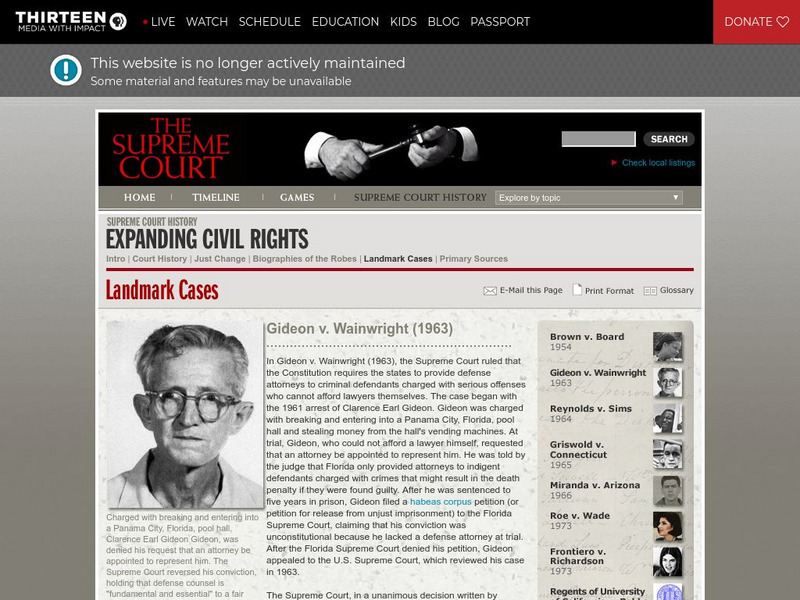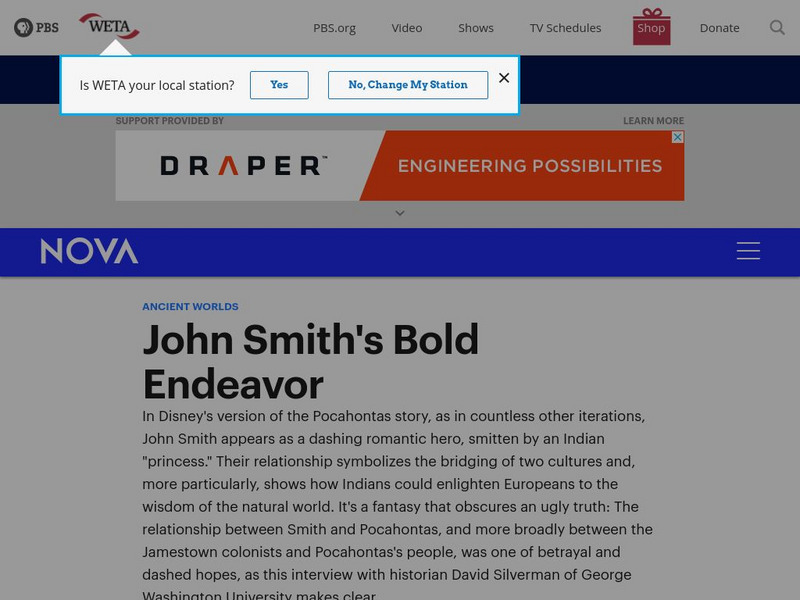PBS
Wnet: Thirteen: Slavery and the Making of America: Slave Religion
What religions did slaves bring from Africa to America? This PBS series site provides the historical overview of how early African Americans preserved African spiritual beliefs and practices while enslaved, converted to Christianity, and...
PBS
Wnet: Thirteen: Slavery & the Making of America
Using primary documents, oral histories, and other historical resources, discover how the arts of Africa, Europe, and pre-Civil War America influenced the culture of enslaved African Americans.
PBS
Wnet: Thirteen: Freedom: A History of Us: Wake Up, America!
This resource covers the changing of America due to the Industrial Revolution which brought in not only new technology but also opened the door to reform movements. From the series by Joy Hakim, "A History of Us." Includes a teacher's...
PBS
Wnet: Thirteen: Texas Ranch House
What was it like to be a cowboy in 1867? Visit the Cooke Ranch and explore a cowboy's working and dwelling quarters. Play the interactive games to learn about the many aspects of daily life in the American West. (Click "Interactive...
PBS
Wnet: Thirteen: Freedom: A History of Us: The Peacemaker
Find a document containing President Wilson's plan for peace after World War I, known as his Fourteen Points, as well as photographs with captions, and the audio of one of his speeches in which he lays out his ideas and garners support...
PBS
Pbs Treasures of the World: Guernica Testimony of War
A wonderful site describing Pablo Picasso's "Guernica," a mural he created for the 1937 World's Fair. The resource examines the civil war raging in Picasso's homeland of Spain and the frustration he felt toward the violence taking place...
PBS
Pbs: The Murder of Emmett Till: People & Events: Lynching in America
Article summarizes the impact of lynching on African Americans and the events and people related to the issue.
PBS
Wnet: Thirteen: Supreme Court: Expanding Our Civil Rights: Gideon v. Wainwright
This is a synopsis of the landmark Supreme Court case of Gideon v. Wainwright, which ruled that states must provide defense attorneys to any indigent criminal defendant charged with a felony. The decision was written by Justice Hugo Black.
PBS
Art:21: Art in the Twenty First Century
The online home of award-winning PBS television series "Art:21" opens a window into the world of contemporary art and artists. Includes a lessons library, downloadable educator guides, examples of student-created projects inspired by the...
PBS
Pbs: American Experience: Public Enemy #1: Gangsters During the Depression
"Gangsters" in the Great Depression were divided into two different groups: Mobsters and Outlaws. This article discusses the differences between the two and the role each group played.
PBS
Pbs: American Experience: Timeline of the Influenza Epidemic
This site provides you a timeline of the influenza epidemic from March 1918 to December 1918 with a description of what happened during these months.
PBS
Pbs: American Experience: The Elements of Steel
This interactive site allows students to explore the types of elements that compose different kinds of steel. There is also information explaining how each element affects the function of the steel.
PBS
News Hour: Mexicans React to Immigration Crisis in u.s. (2006)
Fascinating look at the Mexican viewpoint of the immigration debate in the United States. Transcript, audio, and video of this July, 2006, report available.
PBS
Pbs: Journey to Planet Earth: Land of Plenty, Land of Want
Part of the PBS series "Journey to Planet Earth," this site explores the "fundamental problem facing today's farmer: how to feed the world's growing population without endangering our environment." Includes video and educational resources.
PBS
Pbs: Nova: John Smith's Bold Endeavor
A historian discusses the relationship between John Smith and Pocahontas, and, more broadly, the competing expectations of the Indians and English colonists in terms of the relationship of the two groups.
PBS
Nova: Atom Builder
Find out if you know enough about atoms to build them. The goal of the activity is to build an atom of a particular element by dragging the correct numbers of neutrons, protons and electrons into the atom.
PBS
Pbs Teachers: Electric Money Teaching Guides (History of Money Resources)
Five teaching guides containing interdisciplinary lessons that can be used to explore the characteristics of money; how credit, debit, and smart cards work; financial markets and transactions; and similar topics. Designed as complements...
PBS
Pbs: Electronic Money Unit
Electronic Money is a PBS series of five classroom (grades 9-12) activities and lessons which include great support material on evolution of money and the e-money revolution.
PBS
Nova Online: How Cells Divide, Mitosis vs. Meiosis
Slideshow of mitosis and meiosis side-by-side. It is a summation of the two processes and the differences between them are clear.
PBS
Pbs Teachers:monster of the Milky Way: Birth of a Black Hole
Discover how a dying star can be reborn as a black hole. View a slide show that follows the progression of events from an old, dying star to newborn black hole.
PBS
Pbs Nova: Deep Sea Invasion: Battling Introduced Wildlife
Many species that have been introduced for the purpose of dealing with a problem such as erosion or a rat epidemic, instead become invasive. How can these invasive species be eradicated? Eminent ecologist Dan Simberloff explains some of...
PBS
Pbs: Empire of the Air: Power and Impact of Radio
Young scholars will listen to historic news events as broadcast on radio, view current news coverage on television, and compare and contrast how those events were reported on both media by developing an essay which addresses the question...
PBS
Pbs Learning Media: Curious George: Sail a Boat
In the Curious George video Junky Monkey, George sees treasures where others see trash. He transforms his junk collection into a masterpiece- reusing and recycling items from the street. Will the mayor declare George and his friends the...
PBS
Pbs Kids: Dragonfly Tv Try This!
A collection of simple experiments your students will enjoy! Each activity only requires a few household items, and will certainly spark the creativity in young scientists!



